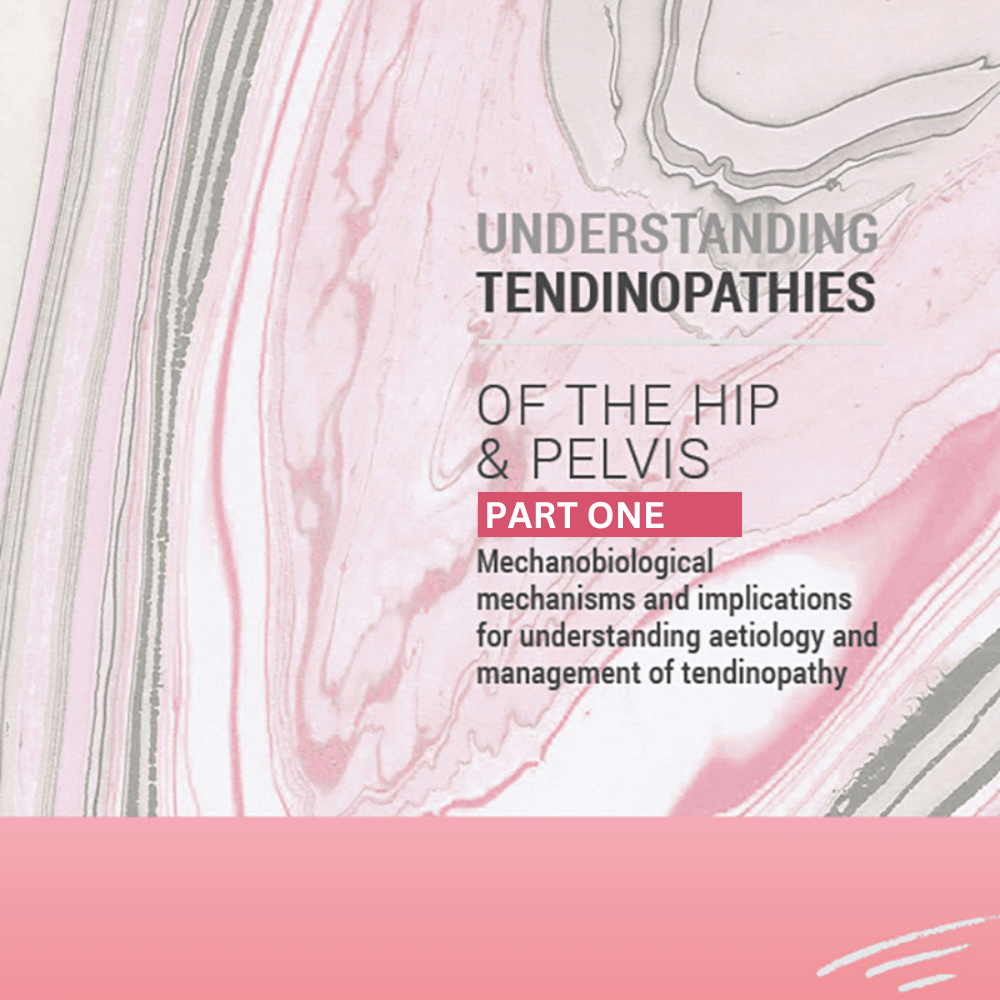The clinician's handbook: Understanding Tendinopathies of the Hip & Pelvis
All the answers at your fingertips!
Keep this comprehensive hip tendinopathy book on your desk for easy, evidence-based answers. Improve your understanding, diagnosis and management of gluteal tendinopathy, proximal hamstring tendinopathy, and iliopsoas and adductor related groin pain. For Health and Exercise Professionals who put best patient outcomes first.
AUD$145
+ P&H
A4 size, 228 pages, Full Colour Print

The clinician's handbook: Understanding Tendinopathies of the Hip & Pelvis
All the answers at your fingertips!
Keep this comprehensive handbook on your desk for easy, evidence-based answers. Improve your understanding, diagnosis and management of gluteal tendinopathy, proximal hamstring tendinopathy, and iliopsoas and adductor related groin pain. For Health and Exercise Professionals who put best patient outcomes first.
AUD$145
+ P&H
A4 size, 228 pages, Full Colour Print
Are you a health or exercise professional dealing with musculoskeletal pain and injury?
If so, chances are that you are regularly diagnosing and treating people with tendinopathy, and hip tendinopathies are some of the most common and impactful tendinopathies with which patients present to generalist clinics. Our challenges are to understand these conditions so we can get the diagnosis right the first time, and provide effective and evidence-based patient education and exercise programs. It’s hard to keep up to date with every tendinopathy, so I’ve packed all the information you need on hip tendinopathies in this comprehensive 228 page manual.
Developed by physiotherapist-researcher Dr Alison Grimaldi, this book combines the evidence and over 30 years of clinical experience to bring you a highly practical handbook for clinicians. This handbook will first help you understand tendinopathy in general and will then dive deep into specific pathoaetiological, diagnostic and management information for gluteal tendinopathy, proximal hamstring tendinopathy and iliopsoas and adductor related groin pain. Complete with detail around diagnostic tests, patient education and targeted exercises. Order your book today and keep it on your desk for easy reference!
AUD$145
+ P&H
A4 size, 228 pages, Full Colour Print
About the Author

Dr. Alison Grimaldi BPhty, MPhty(Sports), PhD, FACP
Dr Grimaldi is a physiotherapist with over 30 years of clinical experience, and a fellow of the Australian College of Physiotherapists. She was a key investigator in the successful LEAP clinical trial for gluteal tendinopathy, is an author of 25 peer-reviewed papers on hip tendinopathy and groin pain, and is listed on Expertscape as a one of the top researchers worldwide with expertise in tendinopathy. She continues as a practising clinician, researcher and global educator in this field.
How this Hip Tendinopathy book will help you as a clinician
1. Understand the WHY
To optimise treatment outcomes for hip tendinopathies, first understand the 'Why'. Why is my patient experiencing tendon pain at the hip? This comprehensive hip tendinopathy book will first help you understand the details of why tendons may alter their structure and sometimes become painful. For all the major hip tendinopathies, we then step through comprehensive explanations of local anatomy, pathology and pathoaetiology and associated impairments that impact on function. This background understanding is the foundation of accurate diagnosis and optimal management planning.
1. Understand the WHY
To optimise treatment outcomes for hip tendinopathies, first understand the 'Why'. Why is my patient experiencing tendon pain at the hip? This comprehensive hip tendinopathy book will first help you understand the details of why tendons may alter their structure and sometimes become painful. For all the major hip tendinopathies, we then step through comprehensive explanations of local anatomy, pathology and pathoaetiology and associated impairments that impact on function. This background understanding is the foundation of accurate diagnosis and optimal management planning.
2. Get the diagnosis right the first time
Diagnostic delay can often lead to delay in receiving appropriate treatments and sometimes delivery of provocative treatments, due to a lack of understanding of the patient's condition. Pain associated with hip tendinopathies is often misdiagnosed as lumbar or hip joint related pain, the 2 most common differentials. While some treatments or exercises might help any of these conditions, some approaches to lumbar and hip joint related pain may be counterproductive in the management of hip tendinopathies. This hip tendinopathy book aims to help you more easily recognise hip tendinopathies, so you can get your patients on the right path as quickly as possible.
2. Get the diagnosis right the first time
Diagnostic delay can often lead to delay in receiving appropriate treatments and sometimes delivery of provocative treatments, due to a lack of understanding of the patient's condition. Pain associated with hip tendinopathies is often misdiagnosed as lumbar or hip joint related pain, the 2 most common differentials. While some treatments or exercises might help any of these conditions, some approaches to lumbar and hip joint related pain may be counterproductive in the management of hip tendinopathies. This hip tendinopathy book aims to help you more easily recognise hip tendinopathies, so you can get your patients on the right path as quickly as possible.
3. Ensure you are implementing key patient education strategies for hip tendinopathy
One of the treatment approaches for tendinopathy that appears to be integral to both short and long term optimal outcomes, is patient education. In the early phases of rehabilitation, helping the patient understand their condition and how to best manage it by controlling activity levels and adjusting specific types of tendon loads returns rapid rewards in terms of pain relief. In the longer term, continuing principles of graduating load and adjusting specific loads if symptoms return, makes the patient their own best manager. High-quality patient education is truly the gift that keeps giving! In this hip tendinopathy book, you'll find all the detail your need to help your patients understand and better manage their tendinopathy.
3. Ensure you are implementing key patient education strategies for hip tendinopathy
One of the treatment approaches for tendinopathy that appears to be integral to both short and long term optimal outcomes, is patient education. In the early phases of rehabilitation, helping the patient understand their condition and how to best manage it by controlling activity levels and adjusting specific types of tendon loads returns rapid rewards in terms of pain relief. In the longer term, continuing principles of graduating load and adjusting specific loads if symptoms return, makes the patient their own best manager. High-quality patient education is truly the gift that keeps giving! In this hip tendinopathy book, you'll find all the detail your need to help your patients understand and better manage their tendinopathy.
4. Select more specific exercises for hip tendinopathy
Patients with hip tendinopathies who are prescribed generic hip exercise programs, often struggle to progress due to the provocative nature of certain exercises. For example, clams or clamshell exercises and hip flexion/adduction glute or ITB stretches are often prescribed for those with hip pain, but these can irritate pain associated with gluteal tendinopathy. Hip hinge/deadlift type exercises and hamstring stretches may be prescribed for those with buttock or hamstring symptoms, but these can aggravate symptoms for those with proximal hamstring tendinopathy. This hip tendinopathy book provides you with evidence-informed exercise programs for each tendinopathy and guidance as to which exercises may be best avoided or minimised, and why.
4. Select more specific exercises for hip tendinopathy
Patients with hip tendinopathies who are prescribed generic hip exercise programs, often struggle to progress due to the provocative nature of certain exercises. For example, clams or clamshell exercises and hip flexion/adduction glute or ITB stretches are often prescribed for those with hip pain, but these can irritate pain associated with gluteal tendinopathy. Hip hinge/deadlift type exercises and hamstring stretches may be prescribed for those with buttock or hamstring symptoms, but these can aggravate symptoms for those with proximal hamstring tendinopathy. This hip tendinopathy book provides you with evidence-informed exercise programs for each tendinopathy and guidance as to which exercises may be best avoided or minimised, and why.
The Breakdown
Part 1: THEORY
Mechanobiological mechanisms and implications for understanding aetiology and management of tendinopathy
This first module dives deep into the mechanobiological mechanisms associated with tendinopathy. First, an understanding of basic tendon structure is required before introducing the molecules that maintain homeostasis and exploring the influence of cytokines and mechanical loading.
Part 2: GLUTEALS
Greater Trochanteric Pain – Gluteal Tendinopathy & Associated Pathologies
This module builds on the understanding of mechanobiological mechanisms associated with tendinopathy and explores specific research findings for gluteal tendinopathy and the clinical implications for assessment and management of this common condition.
Part 3: HAMSTRINGS
Proximal HamstringTendinopathy & Associated Pathologies
This module details mechanobiological mechanisms of proximal hamstring tendinopathy and the clinical implications for assessment and management of this condition, common particularly in the running population. Local structural and functional anatomy, together with known patho-anatomy is examined prior to discussion of the pathoaetiological model.
Part 4: HIP FLEXORS AND ADDUCTORS
Iliopsoas & Adductor Related Groin Pain
This module explores two common groin pain clinical entities, adductor-related and iliopsoas-related groin pain. The adductor and iliopsoas tendons play a key role in these clinical entities, either as a pain source or a mechanism by which forces transferred by the tendon to adjacent structures results in pain or injury.
AUD$145
+ P&H
A4 size, 228 pages, Full Colour Print

PREFER TO READ ONLINE?
This book is also available as an ebook series! Perfect for easy access on-the-go, wherever you are! Purchasing the printed book also includes access to these ebooks so you can start learning straight away.
NOTE: The entire eBook series is also included in Hip Academy!

About Dr Alison Grimaldi
Dr Alison Grimaldi is a physiotherapist, researcher and educator with over 30 years of clinical experience. She has completed a Bachelor of Physiotherapy, a Masters of Sports Physiotherapy and a PhD, with her doctorate topic in the hip region. Dr Grimaldi is Practice Principal of PhysioTec Physiotherapy in Brisbane and an Adjunct Senior Research Fellow at the University of Queensland. She is also a fellow of the Australian College of Physiotherapists. She runs a global Hip Academy and has presented over 100 workshops around the world.








